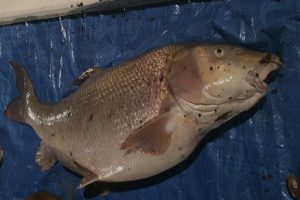Thames Water has been fined £3.34m after millions of litres of raw sewage flooded two rivers near Gatwick.
Judge Christine Laing KC DL told Lewes crown court Thames Water deliberately misled the Environment Agency during its investigation.
The untreated effluent killed several thousand fish after equipment failed in late 2017, and the consequence was sewage pouring into one river and then another for several hours.
Investigators found almost 1,400 dead fish in Gatwick Stream and the River Mole, but the court heard this was a fraction of the number the Environment Agency believes were killed.

Many more would have been lost in vegetation and deep pools or eaten by birds and other animals. An Environment Agency officer said the Mole was “carpeted” with dead fish. Species killed included a large 6lbs barbel, plus bream, chub, gudgeon, perch, pike and roach.
A pump at the company’s sewage treatment works in Crawley was activated in error. This led to a storm lagoon discharging sewage and rainwater into the stream, which pushing it into the Mole, despite there being no significant rainfall. The lagoon should only come into operation in wet weather.
Judge Laing heard that in the days after the incident, Thames Water said its infrastructure had nothing to do with the pollution. However, they later pleaded guilty to four breaches of environmental law.
Jamie Lloyd, a senior environment officer at the Environment Agency and who led the investigation, said:
“Thames Water missed several opportunities to prevent this pollution incident from occurring. Staff appear to have been oblivious to malfunctions at the sewage treatment works leading up to it and did nothing to intervene. When the alarm was raised, no decisive action was taken until the damage was done.
“Thames Water failed to take responsibility for the incident until several years later – and didn’t provide vital information when requested by the Environment Agency during our investigation.
“We brought this case due to the major environmental impact caused, and because it was entirely avoidable. Thames Water failed to have adequate systems in place to manage the pollution-risk from their site and didn’t respond to alarms.”
The Environment Agency told the court it was a “reckless failure” by Thames Water to not put in place systems to avoid the pollution – and to enforce them.
The problems started a day before the incident. A pump at the sewage works, in the shadow of Gatwick Airport, started working incorrectly, filling the storm lagoon with untreated sewage. The next day, that effluent overflowed from the lagoon into Gatwick Stream and the River Mole.
Thames Water had allowed untreated sewage to pour into the rivers from the lagoon outside of storm conditions. That was illegal.
Nearly 5 kilometres of river, full of protected species like European eel and brown trout and countless other fish, were in grave danger. It had been a popular spot for anglers.
The storm lagoon was only three-quarters the legally required size, meaning it filled up with sewage earlier, discharged into the rivers sooner, giving less protection to fish.
A visual check of the storm lagoon would have told them. Staff could have looked at equipment monitoring the rivers and at the water itself. A range of options to mitigate the disaster were available, but all were missed.
Logbooks revealed staff consistently rated equipment as “unsatisfactory” in the months before the incident and several weeks afterwards.
Thames Water pleaded guilty at an earlier hearing to four breaches of the Environmental Permitting (England and Wales) Regulations 2016 regarding the pollution and operation of Crawley sewage treatment works between 9 and 14 October 2017.
In addition to the £3.34m fine, judge Laing ordered Thames Water to pay the Environment Agency’s costs of £128,961.05.
Prosecutions of Thames Water by the Environment Agency for pollution incidents have now led to fines of £35.7m between 2017 and 2023.



